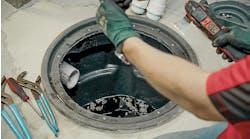ONE OF THE MOST overlooked aspects of starting any hydronic heating system has to be the commissioning process. This is the one area that needs more attention on every job. If you don’t know where you’ve been, how are you going to know where you are headed?
In other words, if you have no idea how efficient the system was at the time it was started, how will you know at a later time whether the system is performing up to par?
Commissioning typically starts at the heat source and works its way throughout the system as a whole. With the boiler, depending on the manufacturer, you will probably have to document the following parameters at a minimum:
- Incoming gas pressure with no load (static);
- Manifold gas pressures at part load and partial stages;
- Manifold gas pressures at full load;
- Incoming gas pressure at full and partial load (dynamic);
- Combustion efficiency at all stages of operation (low burn vs. high burn if applicable);
- All factors used in determining combustion efficiency (CO, CO2, O2, net stack temperature, etc.);
- Amperage draw of blowers, pumps, controls, etc., at all stages of operation;
- Atmospheric conditions at time of commissioning;
- Set-point control settings;
- Modulating control settings;
- Operating temperature of boiler;
- Operating temperature of system;
- A verbal description of control configuration. (Variable speed injection vs. four-way valves vs. three-way);
- A verbal description of control settings at time of commissioning. (slab-idle conditions, slab-melt conditions, sensor sensitivity, etc.);
- Boiler supply and return temperatures with a note about the rate of fire at the time temperature was recorded;
- System supply and return temperatures at startup, with notes about the ambient conditions and other relevant conditions;
- A drawing showing system configuration along with a description of the components used (boilers, pumps, controls, etc.);
- Fluid characteristics at the time of commissioning (pressure and related temperatures, pH, percent glycol, type and brand of glycol, etc.);
- The expansion tank’s initial charging pressures;
- Make-up system parameters (no potable water connections allowed!); and
- Wye strainer’s grit size at time of commissioning.
I would also recommend that a system schematic drawing showing the piping, along with remote manifold locations, be generated for future service calls. A copy of all these items should be permanently stored in the mechanical room in a weather-tight enclosure. I further would recommend that one line and ladder schematic for the control logic be generated and left on site. With the advent of the PC, these drawings are easily made and stored and can be modified with a minimum effort. And they make your company look professional.
It is important to note the locations of the main piping distribution system, if it isn’t quite obvious. You should show the locations of any items that will need future service, such as automatic air-elimination vents, isolation ball valves and drain valves. These locations should be noted on the “as-built” drawings and also in the operating and instruction manuals to be left on site by your company.
We would like to think that we will be the only company to ever work on one of our mechanical wonders, but the truth of the matter is, we don’t always stay in the loop. If we can make someone else’s life easier by doing a good job of documentation on commissioning, maybe the favor will be returned someday.
Looking further out in the system, I would recommend that you note the supply/return temperature differential at the time of commissioning for the individual distribution manifolds. Even if it wasn’t design conditions at the time of commissioning, it is still important to document this information so you have a baseline. Note any adjustments to manifolds that were necessary at the time of commissioning as a part of the balancing process.
As a part of the commissioning process, I always take photographs of the tubing prior to it being covered in concrete. You never know when someone is going to want to install a stop sign or a park bench at some later date and drill into the pavement. If you have documented proof of the tube’s location, you stand a better-than-even chance of avoiding the dreaded emergency tube-repair call. We make a CD copy of the tube photos that is left on site, and we keep a duplicate in our office just in case the one in the field gets misplaced.
I also recommend that you place signs in the mechanical area noting that the system contains corrosion-inhibited glycol. This may keep some poor, first-year service mechanic from inadvertently dumping thousands of dollars of glycol down the floor drain to replace a leaking relief valve. Make the sign with large red letters on a crisp, white background.
And while you are at it, make sure that your company name is well represented in the immediate area of the mechanical room. You never know when some interested party who may want a snow-melt system like the one you just commissioned will come around.
Finally, I make notes in permanent black magic marker on items such as pumps and blower motors, spelling out the frequency requirements for lubrication, along with recommended lubricants. They may not read the manual, but if it’s written on the outside of the equipment, it can’t be missed or misunderstood.
Mark Eatherton is a Denver-based hydronics contractor. He can be reached via e-mail at [email protected] or by phone at 303/778-7772.

